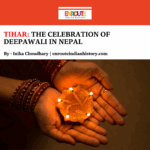Himroo: A Loosing Thread From the History Of Maharashtra
- iamanoushkajain
- June 2, 2025

By Chanchal Kale
Every thread that makes up a fabric we use to adorn ourselves carry a rich history. The clothes we wear today are the result of various social, cultural, political, and economic developments of the bygone eras. One such fabric that reflects Indian history and highlights the political significance of Delhi and Deccan in the Medieval period is the Himroo shawl.
The Himroo is a remarkable textile art form known for its rich and unique craftsmanship. With its exquisite designs and luxurious feel, this traditional fabric has captivated people for centuries. Himroo shawls are composed of a unique blend of wool, silk, and cotton, meticulously woven to create a lightweight, durable, and visually appealing fabric.
The origins of Himroo shawls can be traced back to Aurangabad, Maharashtra, where they emerged during the Tughlaq rule in Delhi. These shawls occupy a significant place in the textile world, celebrated for their intricate patterns, soft texture, and regal charm.
Tracing it’s History
The Himroo shawls are believed to have originated in the fourteenth century CE during the reign of Mohammad bin Tughlaq, who sought to meet the demand of Deccani Muslim rulers for blended silk shawls, resulting in a delicate yet resilient fabric. When Tughlaq relocated his capital to Daulatabad (modern-day Aurangabad or Sambhajinagar) in 1326, several weavers settled in the city. Some valuable trade secrets of Persian shawl-weaving techniques clandestinely made their way to Aurangabad.
Himroo was developed as an imitation of Kinkhwab, incorporating design elements inspired by Persian fabrics. Kinkhwab was a premium luxury fabric woven for royalty, made from pure silk and gold threads. In contrast, Himroo, woven from cotton and silk, became an affordable yet regal alternative for Deccani Muslims. The term “Himroo” is derived from the Persian word “hum-ruh,” which means “similar,” highlighting its resemblance to Kinkhwab.
The warm and humid climate of the Deccan, with relatively short winters, made these delicate shawls a perfect fit for royal embellishments during the winter months in the region. Himroo’s popularity spread across the Mughal Empire, especially during the reign of Aurangzeb, who also made Aurangabad his capital from 1653 to 1707. After the emperor’s death, the city experienced a rapid decline; however, during his reign, the Himroo industry flourished. Members of the royal family and the elite adorned their courts and homes with Himroo shawls, and silk fabrics became a primary
revenue source for the town, which gained global recognition for its handwoven textiles. The Himroo industry also benefited from a growing export market in West Asia, with Himroo shawls sparking significant interest in neighbouring countries, thereby enhancing the image of the Mughal dynasty.
The Marathas also recognized the importance of Himroo, and it soon became an essential component of royal women’s costumes. Under Peshwa rule, these shawls were referred to as “Himroo Shela,” signifying cotton and silk shawls. Following the decline of the Mughal and Maratha Empires in the early eighteenth century, the fabric received considerable patronage from the Nizams of Hyderabad, the new rulers of Aurangabad.
During his travels along the Silk Route, around the 13 th century CE, the Venetian merchant Marco Polo visited the Deccan and described Himroo as the finest cloth in the region. He remarked that kings and queens from any country would take pride in wearing it and was presented with a Himroo shawl as a souvenir from his visit.
In 1673, a Persian ambassador returning to Iran from the court of the Qutub Shahi king was gifted a precious piece of Himroo that had taken five years to complete by master craftsmen. This fabric received glowing accolades from foreign travellers and diplomats who visited India.
Today, this symbol of royalty has evolved into a cultural emblem of Maharashtrian wedding attire. The “Shela,” or silk shawl, has become an essential piece of fabric Maharashtrian brides, allowing them to embrace their cultural roots on their wedding day.
Materials and Motifs
Crafting Himroo shawls is a meticulous process that requires exceptional skill and precision. These shawls are made from wool or cotton as the base material, with intricate designs stitched in silk. Traditional weaving techniques involve the use of a draw loom, where the warp and weft threads are carefully interlaced. Expert weavers create intricate designs and motifs by passing each thread through a series of heddles and combs, showcasing their artistry and mastery of the resulting fabric.
Historically, the textile is woven on a pit loom using the throw-shuttle technique, with the weaver seated at one end and a helper, known locally as the dori uthanewala (“the one lifting the threads”), at the other. This helper lifts the jala threads as needed. In the 1960s and ’70s, master weaver Abdul Hameed Qureshi introduced the jacquard loom to the weaving process, allowing a single operator to manage the entire process, thus making it more cost-effective and efficient.
The fabric is characterized by recurring motifs, including geometric shapes, parallel lines, and hexagons; fruit designs such as diamond mangoes and pineapples; floral motifs and creepers like shamiana, banarasi, and Ambi; and animal motifs, including elephants and birds. Each design tells a story and represents the artistic heritage of Himroo shawls. Notable patterns include the Ajanta pattern, inspired by the Ajanta Caves, and the Ambi pattern, where paisley motifs dominate the fabric.
The base of Himroo shawls is often a dark colour, such as black, pale slate, or mustard, blended with shades of green, blue, and gold. The motifs are woven in lighter colours, such as pink, white, red, and yellow. The intricate detailing and vibrant colours create a visual spectacle, adding elegance to any attire.
Himroo shawls possess several distinctive characteristics that set them apart from other textiles. The fabric is known for being lightweight and breathable, making it suitable for various climates throughout the seasons. The blend of silk and cotton enhances breathability, keeping you comfortable in both warm and cool environments. The speciality of textile weaving in each region develops based on local climate and cultural influences, with specific fabrics suited to the climate of Maharashtra. Additionally, the durability of Himroo shawls ensures they retain their
beauty for generations.
Unfortunately, the traditional making of Himroo shawls is almost extinct, with few remnants of this regal heritage remaining. Changing dynamics in fashion and clothing have led to the replacement of weavers with power looms. As the demand for cost-effectiveness increased, rayon has been used instead of silk, and cheaper chemical dyes have become prevalent. Consequently, Himroo has now shifted into a mere showpiece at art exhibitions.
Current status
The current Himroo handloom weaving in Aurangabad is primarily showcased for tourists at popular shops, but the shawls and stoles marketed as handwoven are produced through a mechanized process. They are designed to closely resemble the original aesthetic, allowing them to be misrepresented as “fresh-from-the-loom” to the untrained eye.
Research by Loom Katha, through interviews with local historians and textile experts, has traced the decline of this traditional art. Its peak occurred in the mid-19 th century, when around 2,500 Himroo handlooms thrived in the city, significantly driving the industry. Now, we have entered a ‘power loom Himroo’ era where only four authentic handlooms remain in Aurangabad, and only two of these are still operational. The report incorporates insights from 25 surviving members of weaving families and others trained under government schemes.
By the late 1950s, although the fabric produced in Aurangabad was widely traded, it faced intense competition from more affordable imitation fabrics created with power looms. During this period, the Andhra Pradesh government established weavers’ cooperatives to assist in the weaving of Himroo, prompting many weavers to migrate from Aurangabad to Hyderabad. Additionally, the Himroo and Nawabpura Cooperative Society Limited was established in 1953, alongside The Himroo Weavers’ Cooperative Society in 1955, both under the Hyderabad Cooperatives Societies Act of 1952.
The Himroo story is deeply rooted in Aurangabad, particularly in Baijupura, Nawabpura, Silk Mills Colony, and Himayat Bagh, where the last-known Himroo handlooms are situated. Understanding the city is crucial to appreciating the work of Himroo craftsmen. Aurangabad, known as the Beer Capital of India, was declared a ‘Smart City’ some time ago, yet it still struggles with basic infrastructure issues, such as poor roads, waterlogging, and violations of city planning norms. Despite being home to several multinational companies, the city faces challenges such as unemployment and low literacy rates. According to Loom Katha’s research, a significant portion of the population, including those in the weaving community, lacks
basic primary education, which adversely affects income levels. Many families report a monthly income of around Rs. 3,000.
The Himroo weavers are situated in a constraining environment with limited resources required for their craft. Himroo weaving is both capital- and labour- intensive, demanding significant investment in space. Weaving one shawl can take up to a week, and the loom used requires an area of 35 square feet with a minimum height of 20 feet. This is a home-based industry that collapses when the loom stops, forcing weavers to seek odd jobs for survival.
Several weaving and training centres have been established under the Government of India to support the craft. While demand for Himroo fabric has grown—particularly among tourists—the number of active weavers in the area continues to decline, a trend exacerbated by the COVID-19 pandemic and its impact on international tourism. The once-thriving Himroo weaving industry is now struggling to survive, and efforts are underway to secure a Geographical Identification (GI) mark for this art form in a bid to prevent it from fading into obscurity.
Conservation Projects
Much credit for preserving the craft in the past goes to the Qureshi family from Aurangabad, who launched a rejuvenation drive a century ago during the time of the Nizam of Hyderabad. Ajaz Ahmed Qureshi, representing the 13 th generation of the renowned Qureshi family, currently runs the ‘Aurangabad Himroo Industry’ and the ‘Paithani Weaving and Training Centre’ in Aurangabad. Both are undertakings sponsored by the Government of India, which provides looms for the work and runs training programs for weavers.
The Himroo story offers some hope. A positive development is that young weavers have shown a willingness to return to their craft. They require guidance at the right time and are ready to follow a structured plan, which highlights the potential of the industry.
To restore the legacy of this royal fabric and prevent it from disappearing, Shailaja Ramaiyer, Director of Handlooms and Textiles, and Mamatha Tulluri, Proprietor of The Designer Studio, have joined forces. Mamatha Tulluri fully supports the next generation of weavers who continue to create beautiful, unique clothing despite facing significant job insecurity. She is also helping with the health and education of the weavers’ children as a proactive step.
Conclusion
Himroo Shall is not just a fabric; it embodies centuries of tradition, craftsmanship, and cultural heritage. Its exquisite beauty and timeless appeal continue to captivate people around the world. Whether it adorns a bride on her special day or adds elegance to everyday attire, Himroo Shall remains a symbol of luxury and sophistication. By cherishing and promoting this art form, we help preserve our rich\ cultural heritage. The handlooms of India deserve our collective support, not only on National Handloom Day but every day of the year. Our identity as Indian people is rooted in the traditional weaves we wear and take pride in.
Bibliography
1. Sumedha Raikar, “Himroo: A Loom Katha”, The Thought Haversack, August 3, 2019, https://thethoughthaversack.home.blog/2019/08/03/himroo-a-loom-katha/
2. “Himroo”, Map Academy https://mapacademy.io/article/himroo/
3. Prof. Bibhudutta Baral, “Himroo Weaving- Aurangabad, Maharashtra, Art of Weaving Figure Fabric”, D’source journal
https://www.dsource.in/resource/himroo-weaving-aurangabad-maharashtra/introduction
4. Rupesh Bidkar, “Himroo Shall Aurangabad Sambhajinagar: Preserving the Timeless Elegance” https://www.onecuriousguide.com/himroo-shall-
aurangabad-sambhajinagar/?amp=
5. Mamatha Tulluri, “Project Himroo”. https://www.mamathatulluri.com/himroo-handloom-fabric
6. “Himroo Fabrics Weaving Tradition, Crafting Elegance Since 1891” https://himroofabrics.in/
7. “The Himroo Revival Project”, Loom Katha https://countercurrents.org/2018/02/himroo-dying-art/
8. “The Lost Art of Himroo Weaving”, Nitakuri https://www.scribd.com/document/546732636/The-Lost-Art-of-Himroo-Weaving



















